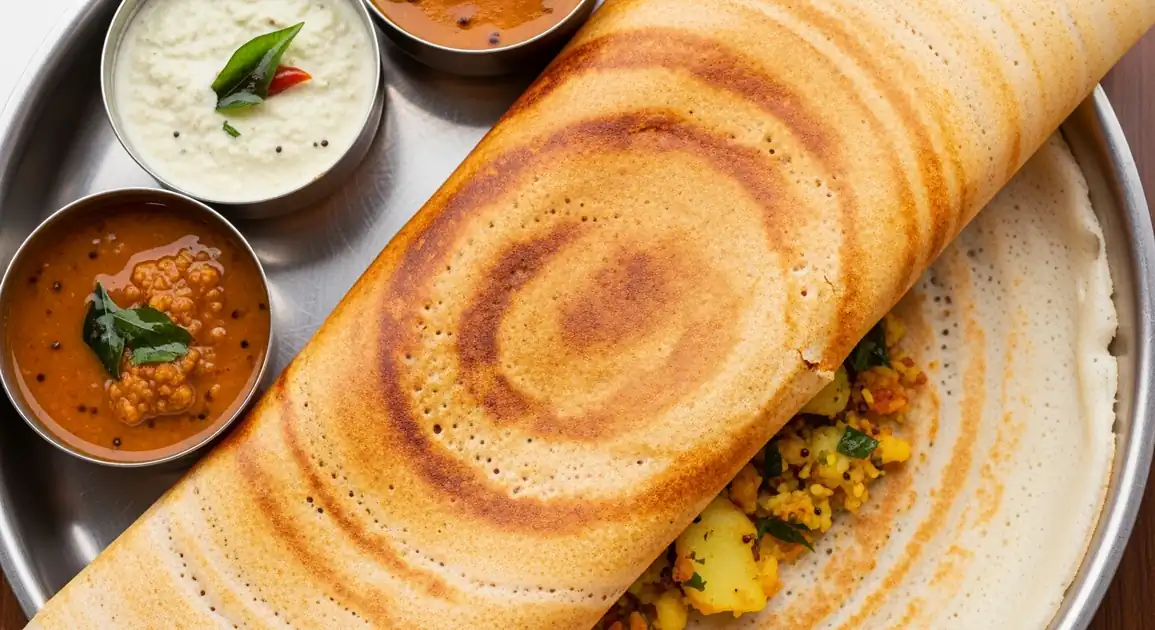Dosa
दोसा (Dosa)

Description
Dosa, while originating from South India, has become widely popular throughout the country. In metros and cities across India, you'll find everything from humble street side dosa stalls to upscale South Indian restaurants serving various dosa types. The preparation varies slightly by region, with North Indian versions sometimes adapting to local preferences with added spices or thicker batters.
Dietary Information
Serving information
Serving style
Typically served on stainless steel plates, banana leaves, or disposable plates. Accompanied by small steel bowls or containers of sambar and 2-3 varieties of chutney.
Quick facts
Most dosa places open early (around 7 AM) for breakfast and operate until 10 PM. Some street vendors may have more limited hours (morning or evening only).
Safety Tips
What to Look For
-
Dosas cooked fresh to order on a clean, hot tawa (griddle)
Ensures proper cooking temperature that eliminates potential harmful bacteria. Fresh dosas have the best texture and taste.
-
Well-fermented batter (slightly tangy aroma)
Proper fermentation (8-24 hours) is crucial for both flavor and improved digestibility. It should have a pleasant sour smell, not overly pungent.
-
Clean storage of accompaniments (sambar and chutneys)
These should be kept in covered containers, with sambar kept hot and chutneys refrigerated when not in use.
-
High customer turnover
Popular places cycle through ingredients faster, ensuring freshness of batter and accompaniments.
-
Transparent kitchen or open cooking area
Allows you to observe hygiene practices and food handling.
What to avoid
-
Pre-made dosas stacked and waiting to be served
Dosas should be made fresh to order. Pre-made ones lose their crispiness and may be stored at unsafe temperatures.
-
Sambar or chutneys left uncovered or at room temperature for long periods
These accompaniments can spoil quickly and should be properly stored.
-
Reused oil with visible smoke or strong smell
Oil used for cooking should be clear and not smoking, as rancid oil affects both safety and taste.
-
Unclean serving plates or utensils
Check for properly cleaned dishes and utensils as basic hygiene indicator.
-
Watery or overly sour batter (sign of over-fermentation)
Over-fermented batter can indicate poor storage and may contain harmful bacteria.
Price information
Price range
Budget tips
- Simple dosas from street vendors typically cost 30-80 INR.
- Special varieties like Mysore Masala or Paper Dosa usually cost more.
- Dosas in air-conditioned restaurants or hotels can cost 100-250 INR.
- Morning and lunch specials often offer better value.
- Some places offer 'mini meals' with smaller dosas at lower prices.
Value indicators
- Freshly made on the spot.
- Generous portion size.
- Complimentary refills for sambar and chutneys.
- Crispy texture with proper golden-brown color.
- Flavorful accompanying sambar and chutneys.
Where to Find This Dish
Urban Markets
Look for South Indian restaurants and eateries in commercial markets.
Local market areas, Shopping centers
Morning, Evening
Business Districts
Many office areas have South Indian canteens or quick-service restaurants.
Office complexes, Business parks
Breakfast, Lunch
Transport Hubs
Train stations and bus terminals often have dosa stalls.
Railway stations, Bus depots
Early morning, Evening
Vendor Tips
- Restaurants with 'Udupi' in the name specialize in South Indian cuisine.
- Watch them make the dosa - it should spread thinly and cook until golden.
- Ask locals for recommendations - reputation matters for dosa quality.
How to Order
Regional Variations
-
Plain Dosa
(सादा दोसा (Sada Dosa))
The basic version with no filling, showcasing the pure flavor of the fermented rice-lentil batter. Thinner and crisper than other varieties.
-
Masala Dosa
(मसाला दोसा)
The most popular variation, filled with spiced potato mixture (aloo masala) containing turmeric, mustard seeds, curry leaves, and sometimes onions and green chilies.
-
Paper Dosa
(पेपर दोसा)
Extra thin and crispy, often served in an impressively large size (sometimes up to 2-3 feet long). Typically served plain or with masala filling.
-
Mysore Masala Dosa
(मैसूर मसाला दोसा)
Features a layer of spicy red chutney spread inside the dosa before adding the potato filling.
-
Rava Dosa
(रवा दोसा)
Made with semolina (rava/sooji) instead of or in addition to rice, creating a lacy, crispy texture with characteristic holes.
-
Onion Dosa
(प्याज़ दोसा)
Made by adding chopped onions, green chilies, and spices to the batter before cooking.
-
Ghee Roast Dosa
(घी रोस्ट दोसा)
Cooked with a generous amount of ghee (clarified butter) for a richer flavor and extra crispiness.
Cultural context
History
Dosa's origins trace back over 2,000 years to South India, particularly Tamil Nadu and Karnataka. Traditionally a breakfast item, it was created as a practical way to ferment rice and lentils for better digestion and nutrition. While authentic dosa remains true to its roots, its journey to North Indian cities like Delhi represents the beautiful culinary cross-pollination within India, adapting slightly to local tastes while maintaining its essential character.
Local significance
Dosa represents the spread of South Indian cuisine across India, becoming a beloved national dish despite regional differences.
Eating customs
- Eaten by hand, tearing pieces and dipping in accompaniments.
- Start from the edges and work your way in.
- Sambar can be poured over portions or used as dip.
- In South India, meals are often served on banana leaves.